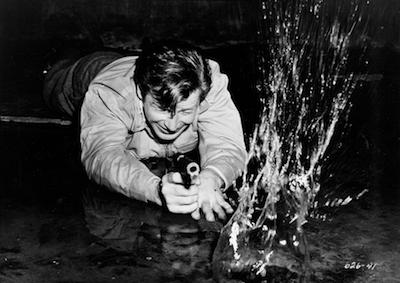Inspired by the true story of Erwin “Machine Gun” Walker's shocking Los Angeles crime spree throughout 1945 and 1946, He Walked By Night is a superbly crafted documentary-style noir thriller released by Eagle-Lion Films and produced by Bryan Foy (eldest son of Eddie Foy and part of the famous “Seven Little Foys”). Known as the “Keeper of the B's” during his previous stints at Warner Bros. and Fox, Foy's team (led by director Alfred Werker and an uncredited Anthony Mann) imbued the production with impressive creativity despite the Poverty Row studio's budgetary limitations. Critical praise was unanimous, with Variety praising the “high-tension crime meller, supercharged with violence but sprung with finesse.”
The film's swiftly efficient parallel narrative structure is divided between the methodical LAPD team led by veteran character actor Roy Roberts and rugged newcomer Scott Brady (younger brother of crime film favorite Lawrence Tierney), and their psychotically-cunning cop killer target (skillfully portrayed by recently discovered stage star, Richard Basehart). Jack Webb, in his first credited film role, plays a forensic technician. The onset friendship that developed between Webb and the film's technical advisor, LAPD Sergeant Marty Wynn, is widely credited as the birth of Dragnet and the modern day pulp-TV police procedural.
Cinematographer John Alton is perhaps the film's greatest asset. In a 2009 Noir City Sentinel interview, the film's script supervisor Arnold Laven stated: “When Alton came to work for Eagle-Lion, nobody had ever heard of him. When he left for MGM everyone knew who he was.” Laven also noted that Alton worked with a trimmed down production team (much to the displeasure of the Hollywood unions) allowing for greater creative control by the director. Alton's expressionistic imagery and use of low-key lighting is particularly well-showcased during the dramatic finale photographed on location in the storm drains of Los Angeles. —Todd Wiener
35mm, b/w, 79 min. Director: Alfred Werker and Anthony Mann (uncredited). Production: Eagle-Lion Films, Inc. Distribution: Eagle-Lion Films, Inc. Produced by: Robert B. Kane. Screenwriter: John C. Higgins, Crane Wilbur. Cinematography: John Alton. Art Direction: Edward Ilou. Music: Leonid Raab. Cast: Richard Basehart, Scott Brady, Roy Roberts, Whit Bissell, James Cardwell.
Restored from the 35mm nitrate camera negative and a 35mm nitrate fine grain master. Laboratory services by Fotokem, Audio Mechanics, DJ Audio, Inc., Simon Daniel Sound. Special thanks to: Metro-Goldwyn-Mayer, Inc., George Willeman, Kevin Sikes.






 Mobile Navigation
Mobile Navigation

